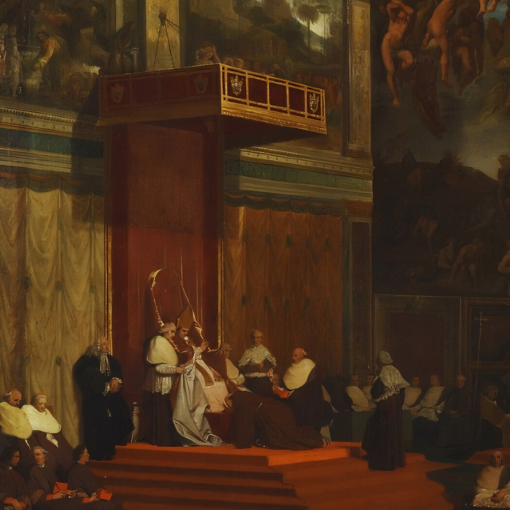Die 11 decembris Anno Domini 2023 Sancti Damasi Papæ et Confessoris
Non in solo pane vivit homo, sed in omni verbo, quod procedit de ore Dei (Mt 4,4)
The office and person of the pope are related and still – despite some confusions – identified with a symbol that for centuries has expressed, manifested and above all synthesized the idea and mature doctrine of the Primacy of Peter, both theologically and juridically.
Currently, the solemn rite of coronation of the Bishop of Rome has been abandoned. A pope has not been seen wearing a tiara for almost sixty years, even though subsequent successors of Paul VI – who was the first to abandon the use of the tiara – had or still have their own papal triple crowns.

Source: A. Kretschmer and C. Rohrbach, The costumes of all nations…, London 1882, sheet no. 81.
What really happened to the papal tiara? Has it been banned? What events are associated with her abandonment? Do the current laws, documents, regulations and liturgical books of the Holy See provide for a coronation or say anything about the papal tiara? What was the process of adapting the papal liturgy and ceremonies to new practices?
This study tries to answer these questions, but it should be noted that it is limited to detailing primarily historical facts – ceremonial and liturgical issues are described only contextually. Issues such as „when the pope used the tiara” or „why there were two tiaras on the papal altar during the solemn Holy Mass” or „when the papal tiara was carried in the ceremonial procession of the papal court” – will be the subject of a separate articles in the future.
I. Pontificate of Paul VI (1963-1978)
1) Papal coronation and the first months of the pontificate
After the election of Cardinal Giovanni Battista Montini, Archbishop of Milan, to the Throne of Peter, it was decided that the solemn coronation of the new pope would take place on June 30, 1963, i.e. nine days after the world heard Habemus Papam! There is not much time to create an artistic work like a tiara, and this was the task faced by the members of the then famous Milanese School of Fra Angelico (Scuola Beato Angelico) – it was entrusted to them after the faithful from the Archdiocese of Milan wanted to donate and fund „their” pope new triple crown.

Source: Scuola Beato Angelico, Archivio Sezione Cesello, Milano / Alessandro Nanni.

Source: ADI Design Museum di Milano, Segni Sacri exhibition. I cento anni della Scuola Beato Angelico / Forum Cattolici Romani.

Source: Farabola / Bridgeman Images.
For practical reasons, the coronation ceremonies were moved to St. Peter’s Square. The basilica was occupied by temporary platforms erected in connection with the ongoing council. In addition, it was decided to simplify the ritual itself, e.g. omitting some elements, which meant that the rituals lasted not almost 5, but „only” 3 hours (exact length of the transmission from the European broadcast band).

Source: Getty Images.

Source: Getty Images.

Source: Getty Images.

Source: Getty Images.
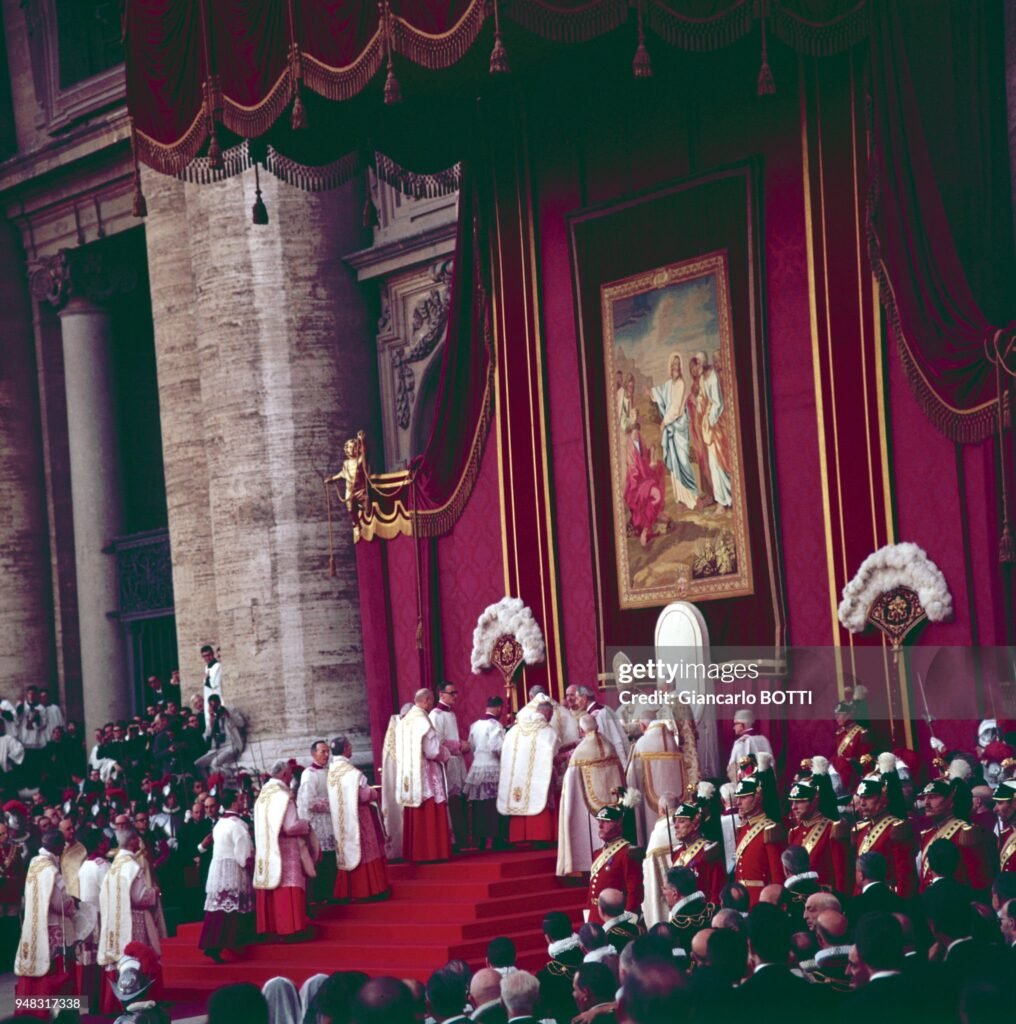
Source: Getty Images.
However, it was not expected that the coronation of Pope Paul VI would be the last ceremony of this type in the history of the Church, nor that the papacy would be deprived so quickly of the symbol that had defined it for the millennium, i.e. the tiara. However, it should be clearly noted that the Holy Father did not use the tiara for the last time during the coronation, contrary to widely repeated reports. Until he symbolically donated his tiara to the poor almost a year and a half later, he used it in accordance with accepted customs, i.e. when he took possession of the Lateran Archbasilica, when he gave Urbi et Orbi blessings (Christmas, Easter) or – for the last time – as he celebrated the first anniversary of his coronation.

Source: Osservatore Romano.

Source: Osservatore Romano.

Source: unknown (photo colorized by AI).

Source: Zuma Press / Alamy (photo colorized by AI).
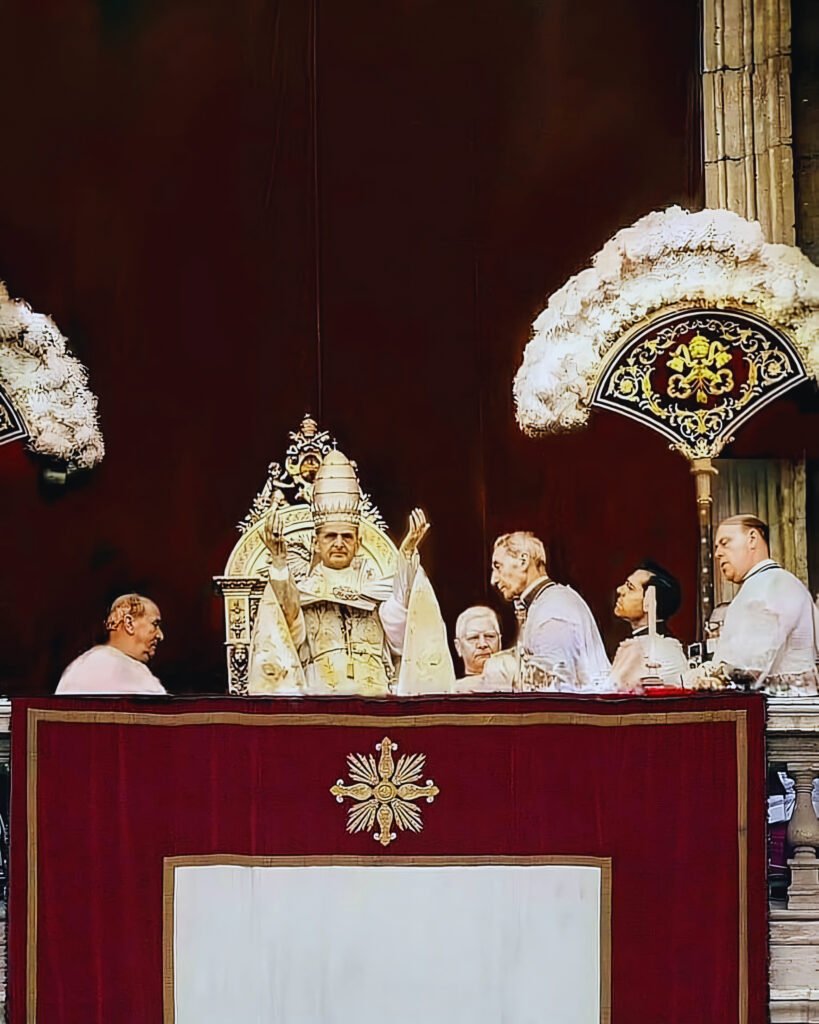
Source: unknown / Nicola De Grandi.
On this day, the Bishop of Rome was last seen with a tiara on his head. Source: eFootage.
On Christmas Day 1964, Paul VI gave a blessing to the City and the World in the bishop’s mitre. Never again did he or any of his successors choose to wear a tiara.
Source: British Pathé.
2) November 1964 – donation of the tiara to the poor and announcement of the Dogmatic Constitution on the Church Lumen Gentium
Paul VI, as expected, decided that the council’s work would continue. The enthusiasm did not fade. Advocates of broad and multifaceted changes, as many accounts depict, led the way. Pope Montini also succumbed to the reform fever then prevailing, which gave rise to numerous controversies. The fever was at times so high that it required emergency medication, even by the Servant of God’s Servants himself. The events that took place during the third session of the Council, especially in November 1964, were symptomatic here. It was then, among others, under the influence of the council’s discussions about the poor, Paul VI decided to make a symbolic gesture of donating his tiara to their benefit.
This month, however, was particularly turbulent due to the promulgation of the Dogmatic Constitution on the Church Lumen Gentium (November 21, 1964), the „compromise” provisions regarding the Papal Primacy and collegiality contained in chapter 3 were „specified further” by the guiding note (Nota praevia of November 16 1964) at the request of the Pope himself. These documents – formulating statements about the double subject of the Primacy – gave rise to the establishment of the Synod of Bishops on September 13, 1965, and the discussion accompanying them at the council had a significant influence on Paul VI, who from November 13, 1964 – that is, from the moment of symbolic laying down the tiara on the altar – used only the mitre common to all bishops. The discussion background and rituals surrounding the abandonment of the tiara clearly indicate that this event is involved in serious theological discussions on the Primacy of Peter, which contradicts the claims that in this case it was only about insignificant external signs of the secular power of the Bishop of Rome.

Source: Revista Humanitas (Chile).
The ceremony of solemn abandonment of the tiara by Paul VI took place on Friday, November 13, 1964 (the Eastern Church honors Saint John Chrysostom on this day), immediately after the ecumenical liturgy celebrated in the Byzantine rite in the Basilica of St. Peter with the solemn assistance of the pope himself. The Divine Liturgy was celebrated – together with several other patriarchs and archimandrites – by the then Melkite Patriarch of Antioch, Maximos IV Saigh (this hierarch had already celebrated the Byzantine liturgy in the presence of the pope, including during the pontificate of Pius XII). During the entire ceremony, Paul VI’s tiara lay on a credence behind one of the pillars of the altar’s ciborium, to the left of the pope (in the photo approximately in the center) – one of the papal masters of ceremonies was watching over it.

Source: CNS / Catholic Press Photo.
After the liturgy, the Pope blessed new mosaics of St. Cyril and Saint Methodius placed on both sides of the altar of St. Wenceslas in the Vatican Basilica. After that, in his pontifical attire and assisted by the Prefect of Apostolic Ceremonies and the cardinals protodeacon (Alfredo Ottaviani) and protopriest (Alberto di Jorio), Paul VI approached the altar where the Divine Liturgy was celebrated and placed his tiara on it. This rite was accompanied by an explanatory commentary delivered by the then general secretary of the council, Archbishop Pericle Felici. Journalists noted in their reports that those gathered began to cheer in honor of the „poor Pope” (Viva il Papa povero!).
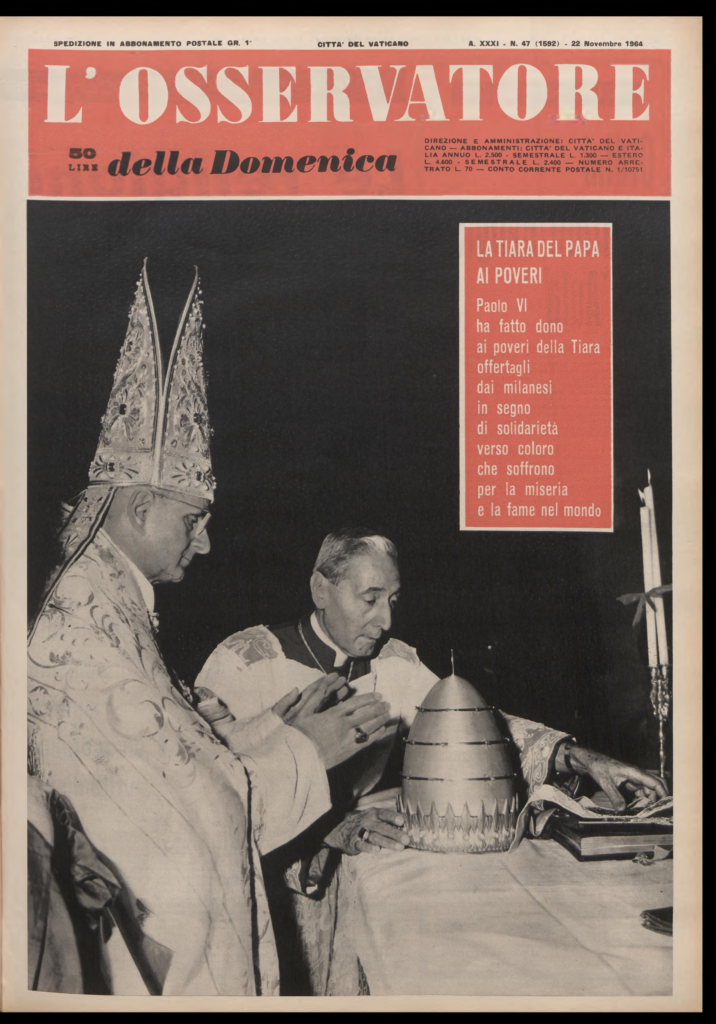
Source: RAI (video) / The Maestors of the Psaltic Art & Preisner Productions (music).
The press office of the Holy See informed and argued that this gesture should be treated as a personal choice of Paul VI, and not as an official resignation from the tiara. It was emphasized that there were still many tiaras in the treasury of the papal sacristy that could be used for their intended purpose. In practice, it turned out that the former Archbishop of Milan never wore the tiara again, although this issue was not regulated in any way for a long time.

Source: unknown / Caeremoniale Romanum (correction with AI).

Cardinal Francis Spellman tried to obtain the tiara of Paul VI. It was given to the Americans as a token of gratitude for their generous and long-term assistance to the poor, especially in the form of food, medicines and clothes. The value of this aid was then estimated at approximately $1.3 billion (currently approximately $12 billion). The papal tiara traveled around the United States until 1968, when it was decided that its permanent home would be the Basilica of the Immaculate Conception in Washington, where the triple crown of Paul VI can be seen to this day.

Source: Imago.

Source: basilica website.
3) Later documents and regulations – reform of the Papal Court and the Apostolic Constitution Romano Pontifici Eligendo
It took three years for any mention of the tiara in Vatican documents. On March 28, 1968, Paul VI announced the motu proprio Pontificalis Domus, which reformed the organization of the Pontifical House, or rather changed the Papal Court (Corte Pontificia) into the Papal House (Casa Pontificia). In chapter 2 devoted to the Papal Chapel (Cappella Pontificia), paragraph 4 states that the abolition is subject to, among others, Custodian of the Papal Tiaras (Custode dei Sacri Triregni). This title traditionally belonged to the Papal Jeweler. Although the document does not mention it, the care of the papal tiaras was taken over by the Sacristan of the Apostolic Palace (an office abolished by Pope John Paul II in 1991). Currently, the treasury of the papal sacristy falls under the competence of the Office of Papal Liturgical Celebrations.

Source: Getty Images.

Source: St. John’s University Archives: Digital Collections.
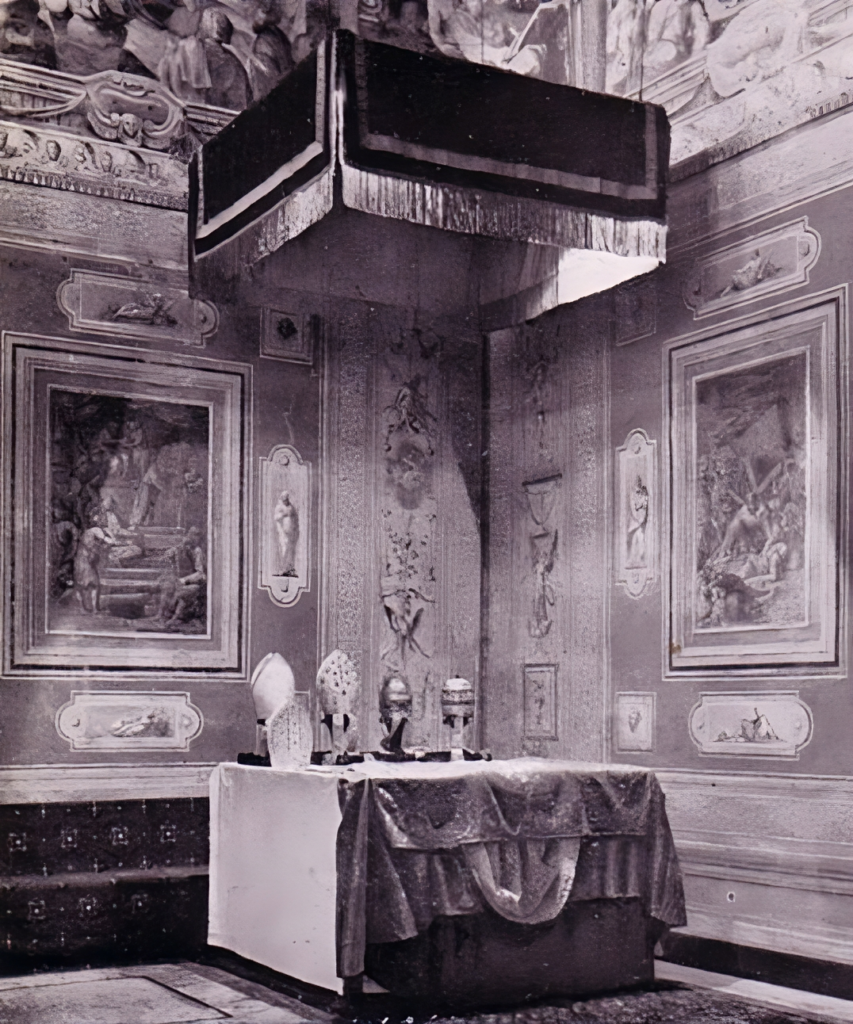
Source: Ceremonia y rúbrica de la Iglesia española.
During the pontificate of Paul VI, no document was published that directly mentioned the papal tiara. The Pope also did not decide to make any changes to the papal and Vatican heraldry. Only when he was already in old age, i.e. three years before his death, did he decide to settle the issues related to the death of the Pope and the election of the new Bishop of Rome. Thus, on October 1, 1975, the Apostolic Constitution Romano Pontifici Eligendo was published, which in chapter 7 directly talks about… the papal coronation, both in the title and in the paragraph devoted to it. The title of the chapter is: „Acceptance, announcement and coronation of the new pope” (De acceptanceione et proclamatione electionis necnon de coronatione novi Pontificis). The last, 92nd paragraph of the chapter, as well as of the entire document, reads:
Pontifex demum per Cardinalem Protodiaconum coronatur et, intra congruum tempus, Patriarchalis Archibasilicae Lateranensis possessionem ritu praescripto capit. "Finally, the Pope will be crowned by the Cardinal Protodeacon and will in due course take possession of the Patriarchal Archbasilica of the Lateran, according to the prescribed rite."
Having had so much time to think (11 years had passed from the moment he got rid of the tiara to the announcement of the constitution), Paul VI decided that his choice would not bind his successor and that it would be up to him to introduce any legal changes. Therefore, there is a certain inconsistency and/or fear of formally touching upon this venerable tradition, deeply rooted in the life of the Holy See – despite so many changes introduced in the Church so quickly and with such great enthusiasm after the close of the Second Vatican Council.

II. Pontificate of John Paul I (1978)
After his election to the See of Peter, Pope John Paul I (Albino Luciani) decided that he would not be crowned, and his pontificate would officially begin on September 3 during the Holy Mass inaugurating the „Service of the Supreme Shepherd” (Ministero di Supremo Pastore). The essential sign indicating the primacy of the Bishop of Rome was the imposition of the pallium, which the pope is the only one who can wear it in the whole world. Because John Paul I’s pontificate ended after 33 days, the pope did not have time to announce any legally significant documents or introduce any significant changes. However, he went down in history as the last pope who used a portable throne (sedia gestatoria).

Source: CR collection.

Source: Getty Images.

Source: CR collection.
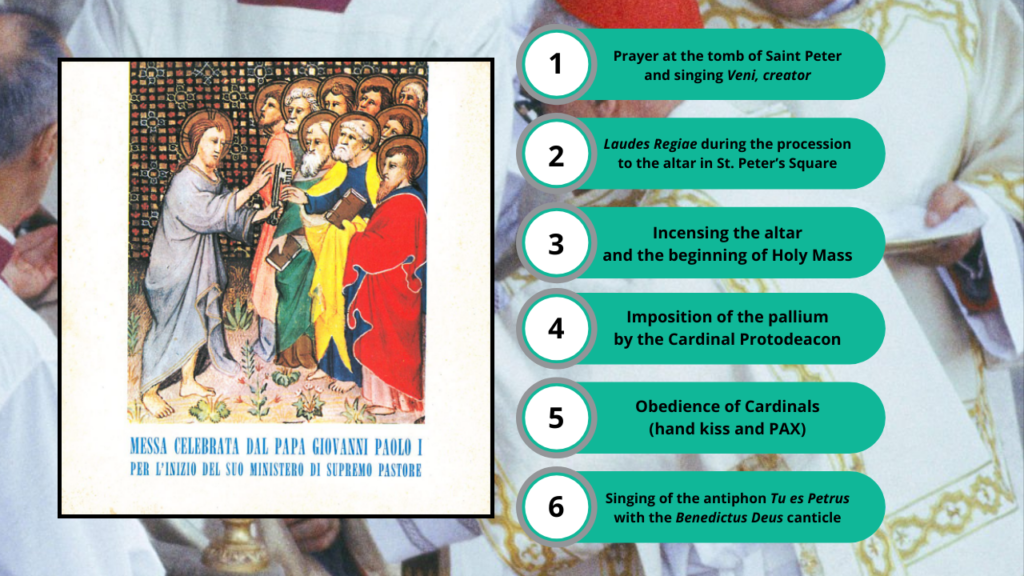
Source: own study.
Source: RAI (video) / CTV (music).
III. Pontificate of John Paul II (1978-2005)
After the election of Karol Wojtyła as the successor of John Paul I, the inauguration rites (October 22, 1978) remained unchanged. However, John Paul II decided to refer directly to the issue of coronation in his homily. The Pope from Poland said:
Nei secoli passati, quando il Successore di Pietro prendeva possesso della sua Sede, si deponeva sul suo capo il triregno, la tiara. L’ultimo incoronato è stato Papa Paolo VI nel 1963, il quale, però, dopo il solenne rito di incoronazione non ha mai più usato il triregno lasciando ai suoi Successori la libertà di decidere al riguardo. Il Papa Giovanni Paolo I, il cui ricordo è così vivo nei nostri cuori, non ha voluto il triregno e oggi non lo vuole il suo Successore. Non è il tempo, infatti, di tornare ad un rito e a quello che, forse ingiustamente, è stato considerato come simbolo del potere temporale dei Papi. "In past centuries, when the Successor of Peter took possession of his See, the triregnum or tiara was placed on his head. The last Pope to be crowned was Paul VI in 1963, but after the solemn coronation ceremony he never used the tiara again and left his Successors free to decide in this regard.Pope John Paul I, whose memory is so vivid in our hearts, did not wish to have the tiara; nor does his Successor wish it today. This is not the time to return to a ceremony and an object considered, wrongly, to be a symbol of the temporal power of the Popes".

Source: CR collection.

Source: CR collection.
Source: RAI (video) / CTV (music).
It became clear that John Paul II did not want to be crowned and would not use a tiara, imitating his two immediate predecessors in this respect. Moreover, he stated directly that, contrary to the current legislation left by Paul VI, both he and his predecessor voluntarily gave up the coronation and tiara, without issuing any appropriate regulations. It should also be noted that the statement regarding Paul VI that he did not use the tiara again after his coronation is clearly false. John Paul II tries to justify his approach by claiming that the tiara was wrongly considered a symbol of the pope’s temporal power. This is, of course, an incomplete view, both from a historical and theological point of view. Moreover, it is difficult to consider such a justification as justified, considering that neither Paul VI, John Paul I nor John Paul II gave up the tiara in their coats of arms, which would seem to be a consequence of similar interpretations.

Source: Getty Images.
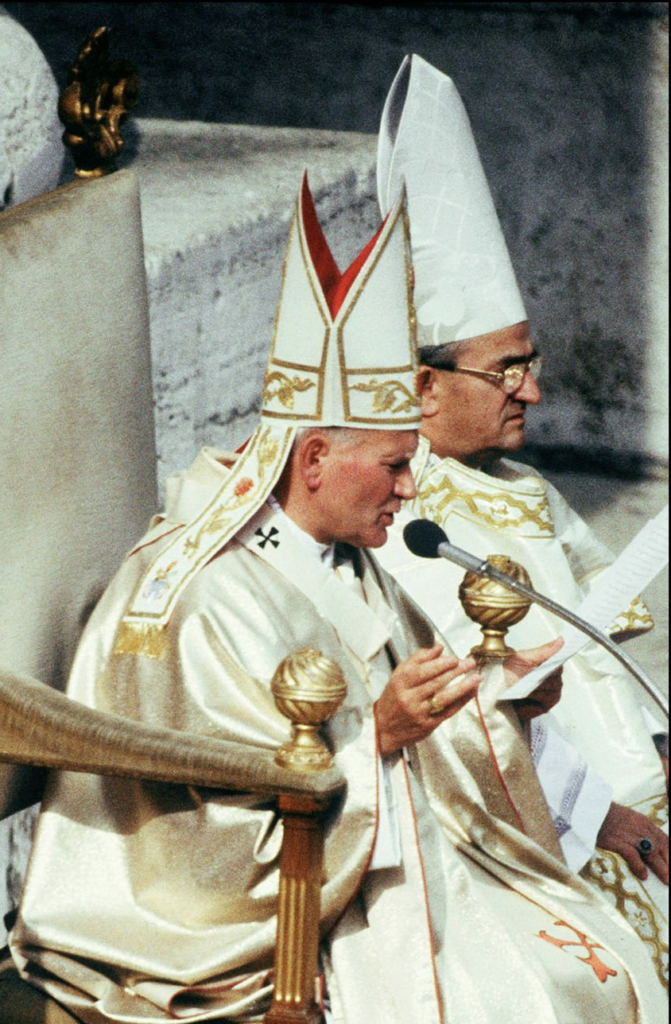
Source: Getty Images.
During his 27-year pontificate, John Paul II referred to the issue of coronation (and indirectly the tiara) only once in official documents. It was the Apostolic Constitution Universi Dominici Gregis, issued only in 1996 (i.e. 18 years after being elected pope), which replaced, but was also prepared on the basis of, the constitution of Paul VI of 1975. Chapter 7 was titled „Acceptance, Announcement and Beginning of the Ministry by the New Pope” (De acceptanceatione, proclamatione et initio Ministerii novi Pontificis). The last paragraph of this chapter, as well as of the entire document (also number 92), reads:
Pontifex, sollemnibus caeremoniis inaugurationis Pontificatus persolutis, intra congruum tempus Patriarchalis Archibasilicae Lateranensis possessionem ritu praescripto capiet. "After the solemn ceremony of the inauguration of the Pontificate and within an appropriate time, the Pope will take possession of the Patriarchal Archbasilica of the Lateran, according to the prescribed ritual".
It is clear at first glance that the wording and structure of this paragraph were taken from the constitution of Paul VI, but „coronation” was replaced by „solemn ceremonies of the inauguration of the Pontificate” (all official translations into modern languages use the singular: „solemn ceremony”). It is interesting that canonists point out, in the case of both constitutions, the narrative (descriptive) rather than normative (prescriptive) nature of this paragraph. Moreover, some believe that the terminology used by John Paul II does not exclude the coronation itself, while others claim that the omission of the coronation clearly expresses the legislator’s intention, which was to abolish the coronation rite. Regardless of which interpretation is chosen, the fact is that coronation (or tiara) has not yet been formally and directly abolished or banned.

IV. Pontificate of Benedict XVI (2005-2013)
At the end of John Paul II’s life, the then Master of Papal Ceremonies, Archbishop Piero Marini, prepared liturgical books related to the death of the Pope and the election of a new one. These are, respectively, Ordo Exsequiarum Romani Pontificis (2000), Ordo Rituum Conclavis (2000) and Ordo Rituum pro Ministerii Petrini initio Romae Episcopi (2005), which were approved by Pope Benedict XVI after his election to the See of Peter (April 20, 2005). This book organized and significantly expanded the rites related to the beginning of the Petrine Ministry, but does not mention a word about coronation or tiara, even in the historical context.
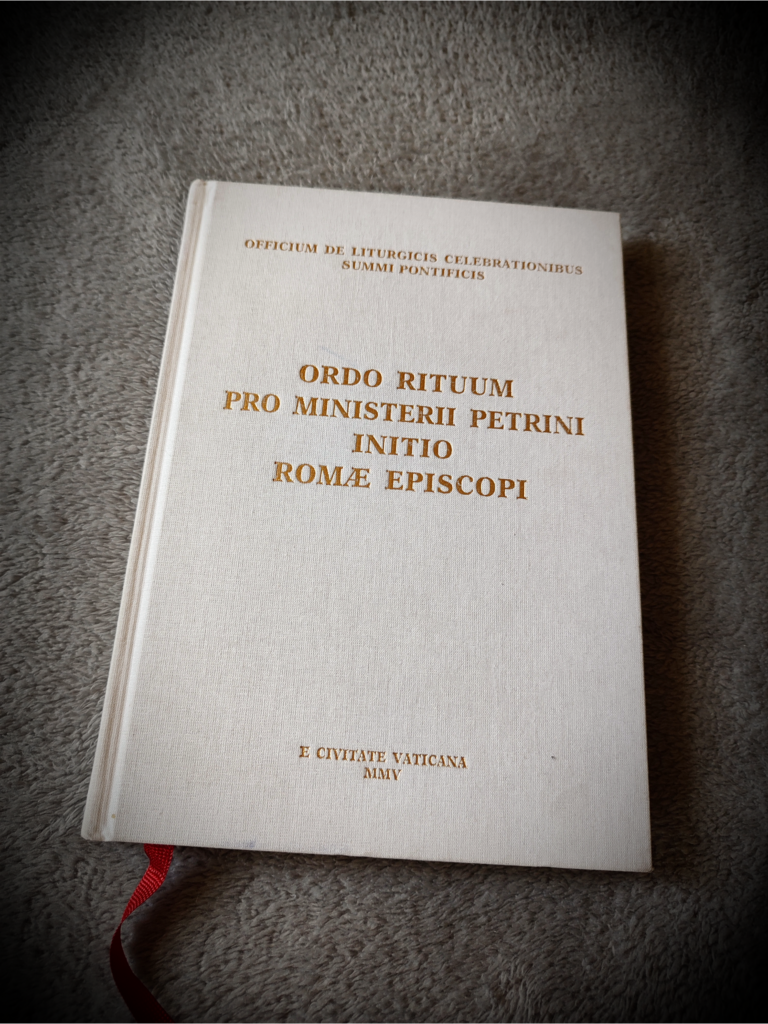
Source: CR collection.

Source: own study.

Source: own study.
The second most important element of the rites related to the beginning of the Petrine Ministry, next to the imposition of the pallium by the Cardinal Protodeacon, was the imposition of the Fisherman’s Ring by the Dean of the College of Cardinals. It was also planned – similarly to the inauguration of the pontificates of John Paul I and John Paul II – the usual obedience of cardinals or (and this was new) 12 representatives of the People of God (clergy and lay people). After announcing his resignation (February 11, 2013), but before leaving office (February 28, 2013), Pope Benedict XVI introduced several changes to the inauguration ceremony (February 18, 2023): he decided that they would take place outside the Holy Mass, and not during it, and that only cardinals will obey the new pope (these rules were applied during the inauguration of Francis’ pontificate).

Source: Getty Images.

Źródło: Getty Images.
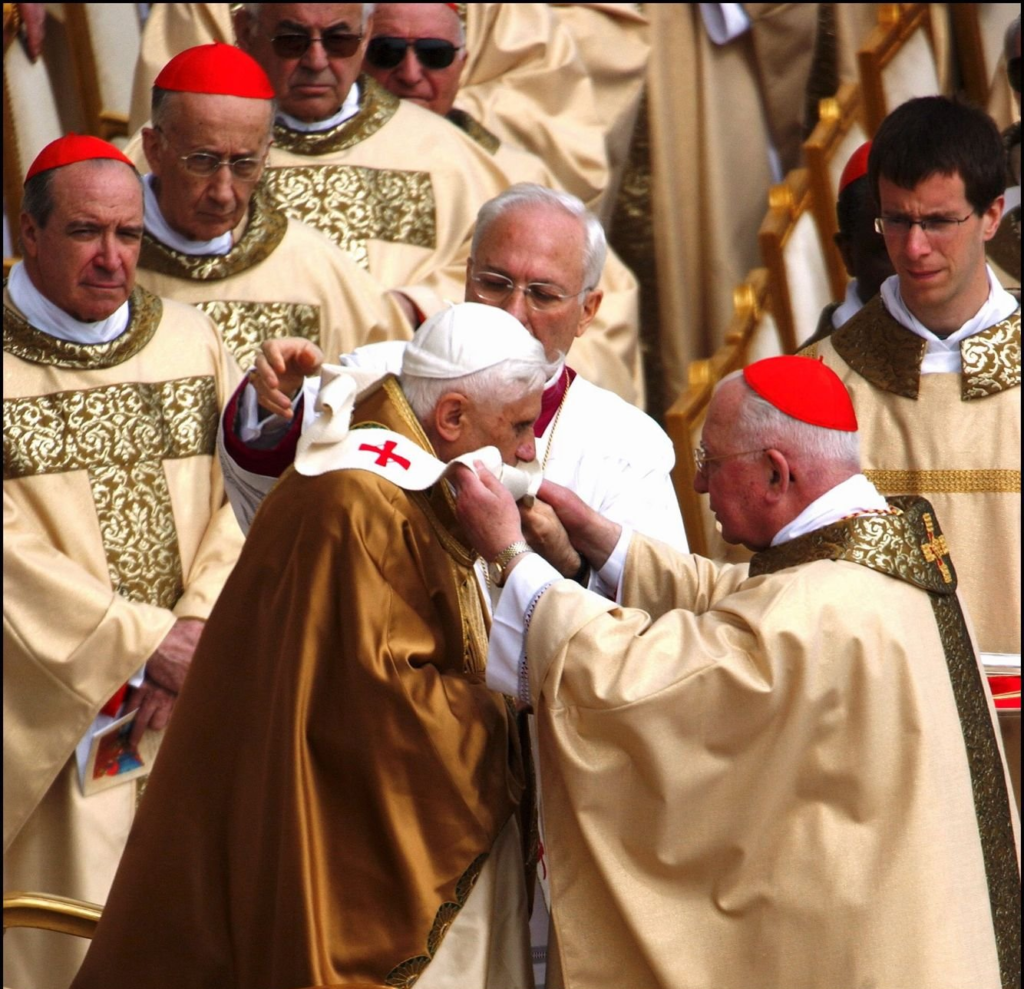
Source: Getty Images.

Source: Getty Images.
Since the Ordo was the first liturgical book of this type after the Second Vatican Council, and published publicly (unlike earlier coronation ceremonies), some canonists claim that its publication ipso facto abolishes coronation, although such a statement does not appear expressis verbis anywhere. The interpretation of the abolition of coronation, and with it the tiara, is to be emphasized by the fact that Benedict XVI was the first pope to abandon the triple crown in his official coat of arms and replace it with a pallium. This caused a stir among heraldry experts.
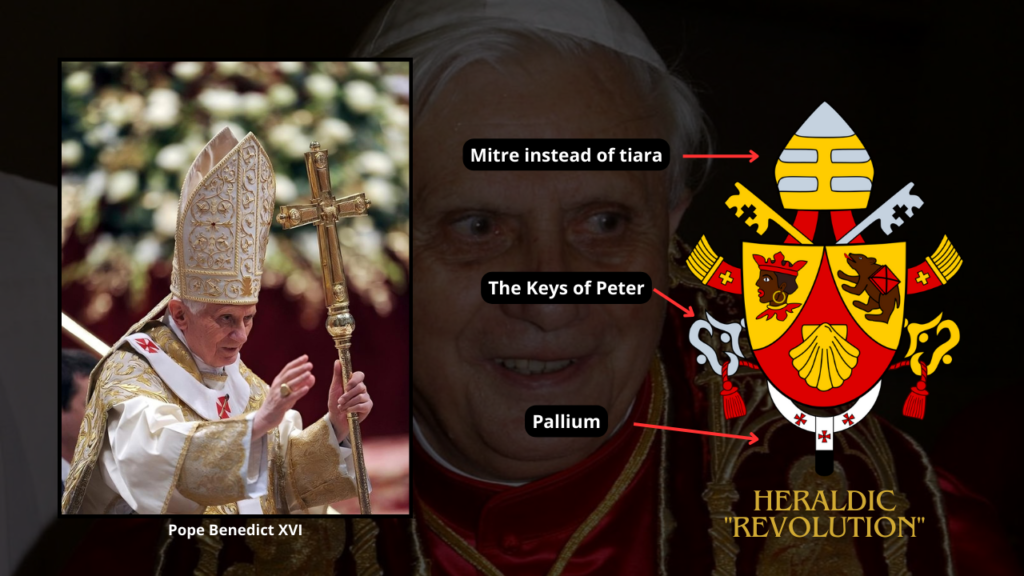
Source: own study.

Source: Wikimedia Commons.

Source: Wikimedia Commons.

Source: Wikimedia Commons.
Indeed, in terms of principles and history it was a small heraldic revolution. In the official Vatican statement, Mons. Andrea Cordero Lanza di Montezemolo explained the changes as follows:
Oggi, giustamente, la cerimonia con cui il Sommo Pontefice inaugura solennemente il suo Pontificato non si chiama più "incoronazione", come si diceva in passato. La piena giurisdizione del Papa, infatti, inizia dal momento della sua accettazione dell'elezione fatta dai Cardinali in Conclave e non da una incoronazione, come per monarchi civili. Per cui tale cerimonia si denomina semplicemente come solenne inizio del suo Ministero Petrino, come è avvenuto per Benedetto XVI, il 24 aprile corrente. "Today, the ceremony that begins a Pontificate is no longer called a "coronation". The Pope's full jurisdiction begins the moment he accepts his election by the Cardinals in the Conclave and not with coronation as for secular monarchs. This ceremony, therefore, is simply called the solemn inauguration of his Petrine Ministry, as it was for Benedict XVI on 24 April".
The author of this statement also noted that Paul VI, despite abandoning the tiara, left it – together with the keys of Peter – a symbol of the Holy See. This has not changed to this day and on the official Vatican website we can find detailed guidelines regarding the flag, coat of arms and seal of the Holy See, which in each case include the tiara and keys of Saint Peter.

V. Pontificate of Francis (2013-)
Even though 10 years have passed since Francis’ election, he has not introduced any changes or possible clarifications regarding the coronation and tiara. He adopted the Ordo Rituum pro Ministerii Petrini initio Romae Episcopi as his rites and, like Benedict XVI, did not include the tiara in his coat of arms. Despite rumors about planned revolutionary changes in the conclave rites and the introduction of further simplifications to the burial rites of the Bishop of Rome, so far there have been no signals of changes regarding the inauguration of the pontificate of Francis’ successor.

Source: VOA.

Source: Wikimedia Commons.

Source: VOA.
To sum up: it can be said that neither the papal coronation nor the tiara have been directly and formally abolished or even banned, despite: firstly, consistently applied ceremonial practice (since November 1964); secondly, the publication of the Apostolic Constitution and the liturgical book, which do not provide for a coronation or say anything about the use of the tiara by the Pope; thirdly, changes introduced in heraldry; fourthly, the declarations of subsequent popes about not crowning themselves and not wanting to use a tiara (although they received one). However, in view of the above statements, it should be recognized that the will of the supreme legislator and, at the same time, the subject of law is expressed in a clear and consistent manner. However, this does not prevent a future successor of St. Peter from discerning that a return to the centuries-old and venerable traditions of the Roman Church will be legitimate, useful and fruitful.
APPENDIX I – Use of the mitre in the coat of arms of John Paul II and the tiara in the coats of arms of Benedict XVI and Francis
An interesting fact is that Pope John Paul II sometimes allowed his coat of arms to be used with a mitre instead of a tiara. It is worth mentioning here, first of all, the placement of such a designed coat of arms in the floor in the Baptismal Chapel of St. Basilica. Peter (October 16, 1994).


While such representations were rare in the case of the coat of arms of John Paul II, during the pontificate of Benedict XVI his coat of arms with a tiara was used very often, both in artistic realizations and in slightly more official situations, and even during papal liturgies (liturgical vestments) or speeches (arras).

Source: Liturgical Arts Journal.

Source: Liturgical Arts Journal.

Source: Liturgical Arts Journal.
The media also commented on the arrangements in the Vatican Gardens, where the coats of arms of Benedict XVI and Francis with a tiara appeared. As the papal gardeners explained: the work was done in accordance with established traditions, also in the case of their profession.

Source: Liturgical Arts Journal.

All such practices should be treated as individual and ad hoc efforts without any official or binding meaning. However, this shows that even in the absence of the presence of the tiara in ceremonies, documents and heraldry, the office and person of the pope are still commonly associated with the inherent attribute of the Bishop of Rome, i.e. the triregnum.
APPENDIX II – Tiaras of post-conciliar popes
The above-mentioned connection is still so strong and present in people’s mentality that it turns out that apart from John Paul I, all of Paul VI’s successors had (still have) their own tiaras. In each case, they were given as a gift to the popes: John Paul II received the tiara in 1981 from the faithful from Hungary; In 2011, Dieter Philippi, a German businessman and famous collector of headgear, gave Benedict XVI a tiara made by a factory specializing in creating liturgical vestments for the Byzantine liturgy; while in 2016, Francis was presented with the tiara by the then president of the Macedonian parliament. None of these tiaras have ever been used or, outside the audience frame, publicly displayed.

Source: Wikimedia Commons.

Source: Liturgix.

Source: Orbis Catholicus Secundus.
Source: CTV / John Sonnen.
It seems that sometimes piety and respect for the Vicar of Christ on earth precede official regulations and applied and recommended practices. After all, the Bishop of Rome is the guarantor of the unity of the Church.
APPENDIX III – Devotion to Saint Peter and his famous statue in the Vatican Basilica
With the famous statue of St. Peter (13th century), which is located in the Vatican Basilica and may have been created by Arnolfo di Cambio himself, is associated with a pious tradition that exists and is practiced to this day. It involves dressing this statue in pontifical vestments (alb, stole, pectoral cross, pluvial with formale also called rationale, ring and tiara) in ceremonies related to the Primacy of Peter (Cathedral of St. Peter on February 22, St. Apostles Peter and Paul on June 29) and during events important for the Church or the papacy (coronation of the Bishop of Rome, solemn session of the council, etc.).




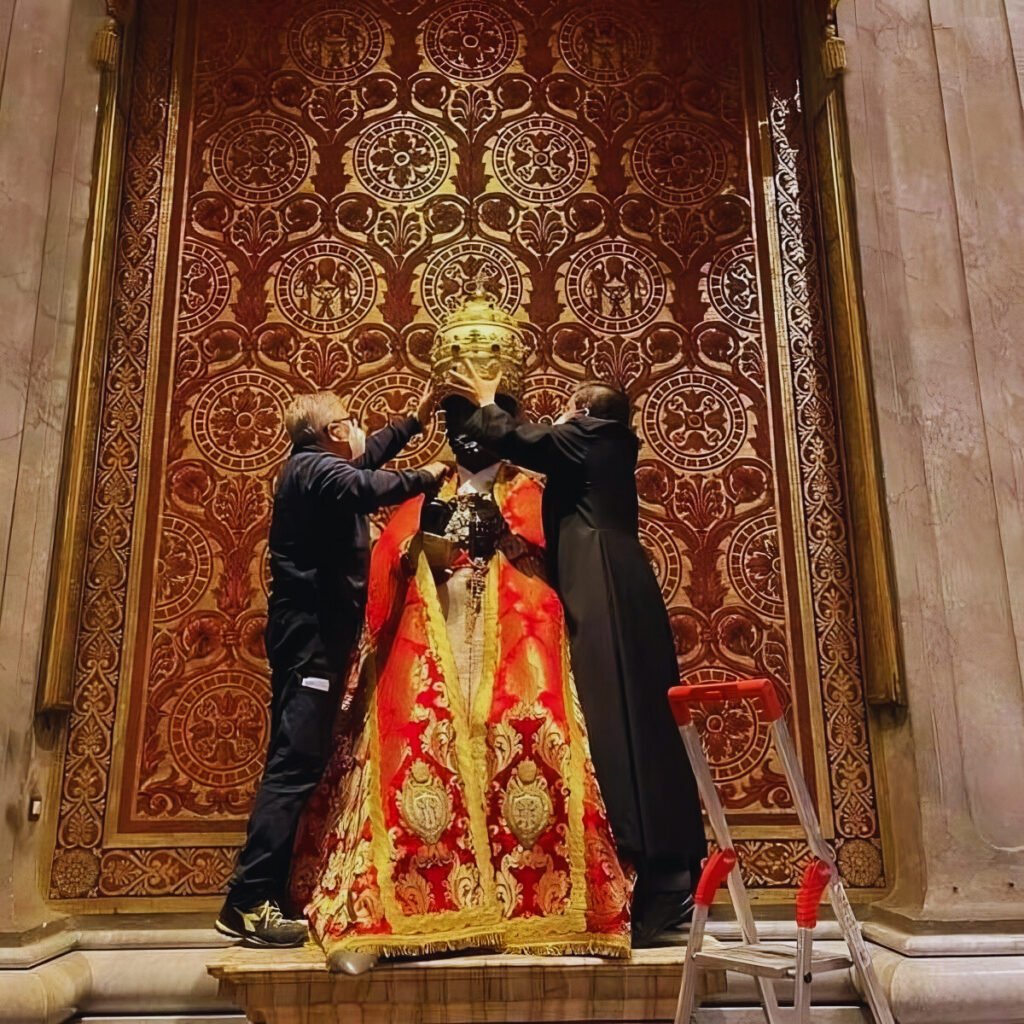
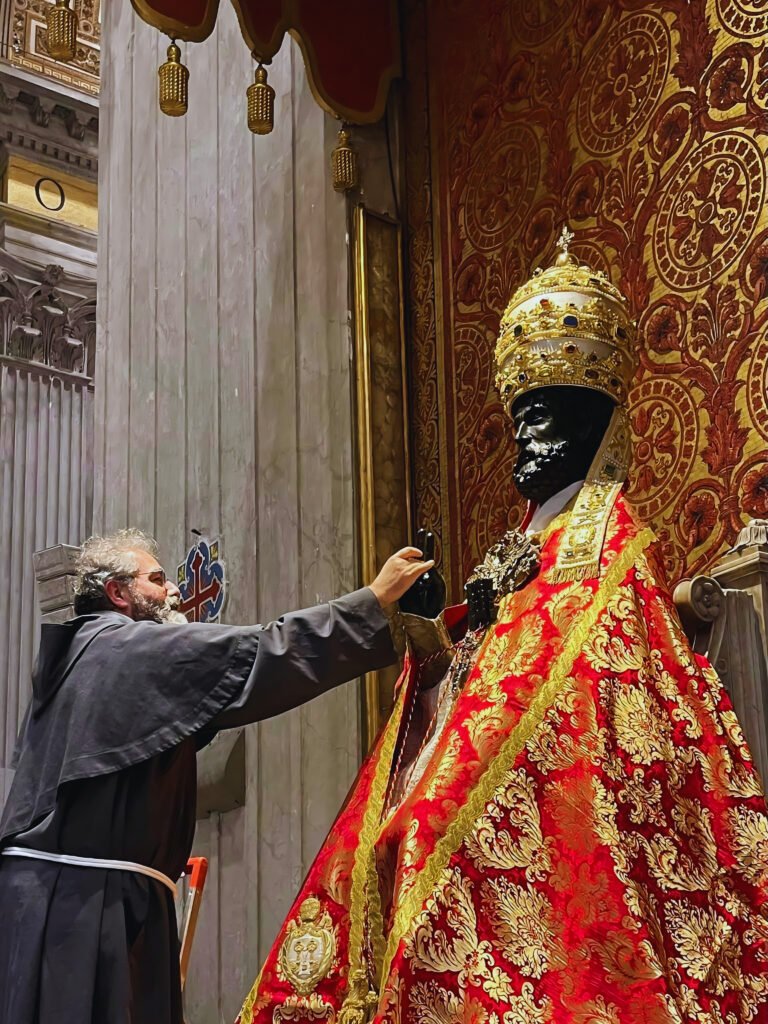

The vestments and insignia in which the statue of St. Peter is dressed can be admired on a daily basis at the Treasury Museum of St. Peter’s Basilica in the Vatican (Il Museo del Tesoro della Basilica di San Pietro). There is another pious practice associated with the statue, namely kissing St. Peter’s foot, or placing one’s forehead against it for prayer. Many artists have devoted their attention and talents to it.

Source: MeisterDrucke.

Source: MeisterDrucke.
RECOMMENDED VIDEOS
RECOMMENDED READINGS
- Eugène Müntz, La Tiare pontificale du VIIIe au XVIe siècle, Paris 1897.
- Ufficio delle Celebrazioni Liturgiche del Sommo Pontefice, Inizio del Ministerio Petrino del Vescovo di Roma Benedetto XVI, Città del Vaticano 2006.
- Andrzej Bruzdziński, Herb Papieża Benedykta XVI. Symbolika i przesłanie, Kraków 2018.


